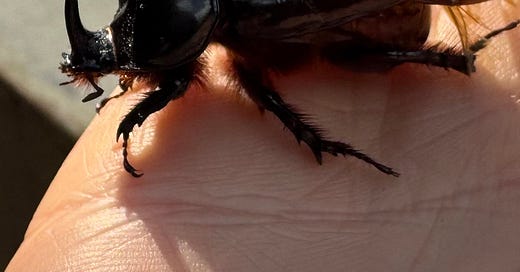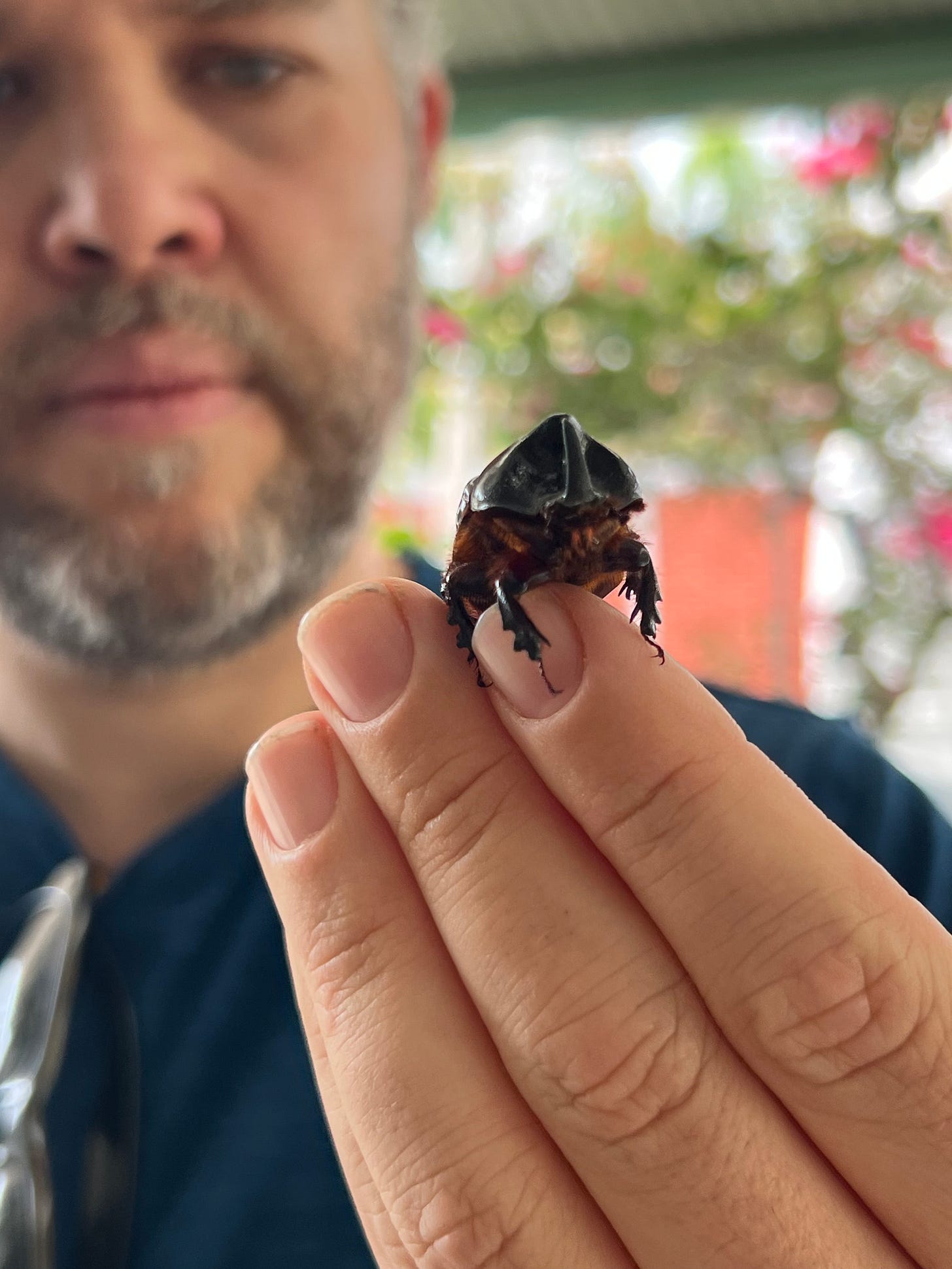The Running of the Toritos
With the arrival of Oaxaca's rainy season came thousands of beetles.
June was ushered into Oaxaca by dense, voluminous clouds and the soft patter of rain, and with those things came the beetles.
Oaxaca has more seasons than people give it credit for, but the two most predominant are the dry season, la temporada seca, and the rainy season, la temporada de lluvia. By spending almost all of May in the United States this year, we were spared the worst excesses of the dry season and avoided several consecutive weeks of blasting sun and unrelenting arid, scorching heat. Even more fortunate, barring the fact that it resulted in substantial tarmac delays and a queasily bumpy flight home, Oaxaca’s season of rains arrived several weeks early. Finally back in our tree-ensconced home, we found refreshingly cooler temperatures, daily rain showers, and a landscape exploding with lush greenery and, a bit more peculiarly, festooned with large, black beetles.
Oaxaca exists in a state of perpetual and unfolding drama, a fact of life we’re still coming to terms with. Despite a certain lackadaisical attitude toward timeliness and consistency that I’ve come to learn is very characteristically Oaxacan (and frustrating for other Mexicans, especially those from Mexico City), Oaxaca is a place that doesn’t show much restraint. Parties here aren’t just big, they’re so epic you have to wonder if every celebration bankrupts the people throwing it. Food is so flavorful, and people eat such large portions and drink such huge quantities of beer and mezcal, that it’s no wonder diabetes is such an issue here. Environments are stuffed with life to the point of absurdity, a wall-less zoo almost everywhere you turn.
Even considering Oaxaca’s perpetual excesses, the beetles feel extreme. One day, out in our village for a walk with Leo and the dogs, we gazed in wonder at the astronomical quantity around us. “There must be hundreds of them!” Andrea exclaimed to me, and we noticed the roads were littered with them, great expanses of sidewalk and asphalt dotted with splotches from where the bugs have been crushed or run over. We’ve noticed the same quantity in the city and other surrounding towns as well. Seemingly, no corner of the Valles Centrales has been spared.
“They’re called toritos, ‘little bulls’, because of their horns,” Edgar told me this past Friday when he caught me in the palapa trying to flip one over with a stick. “They come out during the rainy season, and their grubs are big and fat and white and live underground. Go ahead and pick it up.” I looked at the beetle warily. It was on its back with its legs moving feebly in the air.
Judiciously, I reached down and gingerly placed it on my palm. Right side up, it slowly clambered over my hand, its spiny feet gently clinging to my skin. Its carapace was smooth and cool to the touch, and it seemed more like a kind of weird pet than something that suddenly erupts from the soil alongside thousands of its siblings.
You’d think that handling a large beetle would be unpleasant, but it was an unexpectedly friendly encounter. Toritos are beefy and chitinous little creatures, harmless and so slow-moving and clumsy that any horror you might experience is washed away by their almost comically inept behavior. They also seem to have a high center of gravity, and more often than not, you’ll spy them tipped over, like a modern-day Ford Bronco whose owner has taken a corner too fast only to find their ugly, boxy car flipped over onto its roof. For better or worse, they’re also not subtle. Cockroaches will at least pretend that they’re not invading your home, doing their best to hide under surfaces and sprinting along baseboards in the darkness. Toritos simply don’t care.
The problem with toritos, though, is that they're numerous. They scuttle through the gutters, clamber over roofs. They even managed to find their way into the stove ventilation shaft in the home of our friends Dana and Alan, expats from the United States who moved to San Agustín some months ago. When we bumped into them on the road outside of Paco Pan, Dana recounted with horror how she was cooking at the stove when, suddenly, beetles began tumbling out from above. Within minutes, Alan was dispatched to the roof to plug up the hole they had managed to enter through. While we have yet to find any inside our home, they are nocturnal and attracted to light. At night, we hear abrupt pinging and thunking as they fly headfirst into our windows, as if someone is trying to get our attention by peppering our house with pebbles.
Soon enough, their season will be over, and they’ll depart just as abruptly as they arrived. Toritos are temporary guests, here to mate under the rain and then disappear again until their eggs become grubs deep underground and the next cycle of their life takes hold. And for us, it’s another sign that we live somewhere very far from our original home, in a place with small but frequent surprises and wonders.








Like a cicada invasion but beetles!
I'm going to send this to my husband who will mostly love all of the pictures here 🪲